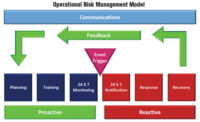In recent months, there have been more unfortunate reminders that threats to life and safety can no longer be considered to be remote and rare possibilities. School shootings, workplace violence, and attacks at public venues from sports stadiums to shopping malls – even churches – still shock us, as they should.
Fortunately, security managers at many institutions – including not only schools but also hospitals, government and retail locations – are taking steps to improve their incident prevention and emergency response procedures. Often, the focus is on creating layers of protection using surveillance and access control systems, among other elements. This increased attention on incident prevention is certain to help – and should lead to the next logical planning question: what happens if despite those efforts, an incident nonetheless occurs? (Remember, the Sandy Hook intruder got past a locked perimeter door.)
As your organization reviews or updates your incident response planning, here are five key elements to consider and incorporate in your plan. Thinking through these elements, and how they apply to your facility and situation, is critical to improve or ensure the effectiveness of your actions.
1. Procedures:Think through the range of possible scenarios, being sure to consider threats beyond what is considered normal, rational behavior. Create or adapt standard operating procedures that will address the scenarios. Make sure they are crystal-clear, and specific to your facilities, community and environment, so they have the best chance of being successfully implemented. Also be clear about any distinction between procedures for different alert levels (such as Lockdown, Shelter, and Evacuate). Set a schedule for reviews and updates to make sure the procedures keep pace with any changes to the building, staffing, or other factors. Make sure your procedures include provisions for handling visitors, who will not be trained in your methods.
2. Training:Once you have developed standard operating procedures (SOPs), ensure that all individuals involved are trained and drilled in all the SOPs and their use. For example, for a school environment, training should include teachers, staff, administration, management and responders, and should cover the range of alert levels and scenarios. As mentioned above, be sure that those involved with visitors know what to do.
3. Time:All parts of the incident response plans should be specifically reviewed for timing. In a crisis, less time equals better outcomes – it is as simple as that. Review plans for opportunities to speed up any and every step without losing the quality of the action: consider the time needed for detection of an incident, informing staff, taking actions such as lockdown, and updating first responders. Do not forget the time needed to decide on a course of action. It is critical that during an incident or crisis the notification time is reduced for everyone, both on-site and first responders.
4. Situational Awareness: In many facilities, significant time is required to move from the entry to the incident location, a process made significantly longer if responders do not know exactly where they are going, or have to physically and methodically search a facility when they arrive. In every way possible, make sure your response plans capture and collect information to provide real-time visibility and updates to those that need it. Ideally, knowing the location of each individual and the status of every location (room or area) involved is the best way to enable responders to quickly monitor, assess and act.
5. Communications: Many parts of your response plans will involve communication. This is true from the beginning of the process, when an incident is detected and reported. It continues through the response, when updating responders and letting people in each room know what they should do and when. And it continues through to resolution, when an all-clear message is sent, or evacuation is complete and messages released to the community, families or press. Timely information that can be shared is important for everyone involved for both minor and life-threatening events. Ensure that you have planned for clear, timely communication in the SOPs.
These keys, combined with an effective physical protection system and well-trained staff will enhance the ability of an organization to respond to an incident and work towards a safe and secure resolution. If you have any doubts or questions, contact your local law enforcement professionals, who are usually glad to provide assistance.




